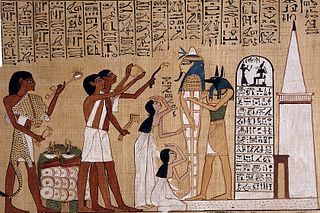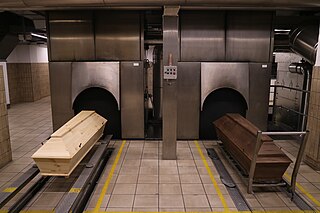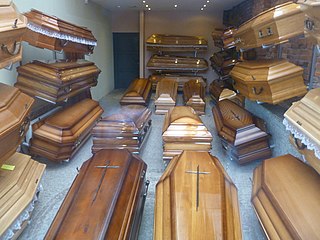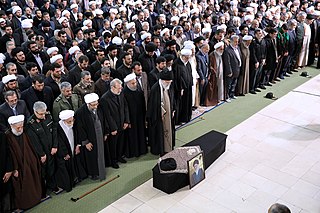
A funeral is a ceremony connected with the final disposition of a corpse, such as a burial or cremation, with the attendant observances. Funerary customs comprise the complex of beliefs and practices used by a culture to remember and respect the dead, from interment, to various monuments, prayers, and rituals undertaken in their honour. Customs vary between cultures and religious groups. Funerals have both normative and legal components. Common secular motivations for funerals include mourning the deceased, celebrating their life, and offering support and sympathy to the bereaved; additionally, funerals may have religious aspects that are intended to help the soul of the deceased reach the afterlife, resurrection or reincarnation.

Cremation is a method of final disposition of a dead body through burning.

Burial, also known as interment or inhumation, is a method of final disposition whereby a dead body is placed into the ground, sometimes with objects. This is usually accomplished by excavating a pit or trench, placing the deceased and objects in it, and covering it over. A funeral is a ceremony that accompanies the final disposition. Evidence suggests that some archaic and early modern humans buried their dead. Burial is often seen as indicating respect for the dead. It has been used to prevent the odor of decay, to give family members closure and prevent them from witnessing the decomposition of their loved ones, and in many cultures it has been seen as a necessary step for the deceased to enter the afterlife or to give back to the cycle of life.

A coffin is a funerary box used for viewing or keeping a corpse, either for burial or cremation.
Embalming is the art and science of preserving human remains by treating them to forestall decomposition. This is usually done to make the deceased suitable for viewing as part of the funeral ceremony or keep them preserved for medical purposes in an anatomical laboratory. The three goals of embalming are sanitization, presentation, and preservation, with restoration being an important additional factor in some instances. Performed successfully, embalming can help preserve the body for many years. Embalming has a very long and cross-cultural history, with many cultures giving the embalming processes religious meaning.
In archaeology and anthropology a mortuary house is any purpose-built structure, often resembling a normal dwelling in many ways, in which a dead body is buried.

In archaeology and anthropology, the term excarnation refers to the practice of removing the flesh and organs of the dead before burial. Excarnation may be achieved through natural means, such as leaving a dead body exposed to the elements or for animals to scavenge; or by butchering the corpse by hand. Following excarnation, some societies retrieved the excarnated bones for burial. Excarnation has been practiced throughout the world for hundreds of thousands of years. The earliest archaeological evidence of excarnation is from the Awash River Valley in Ethiopia, 160,000 years ago. Examples of excarnation include "sky burials" in parts of Asia, the Zoroastrian "Tower of Silence", and Native American "tree burials". Excarnation is practiced for a variety of spiritual and practical reasons, including the Tibetian spiritual belief that excarnation is the most generous form of burial and the Comanche practical concern that in the winter the ground is too hard for an underground burial. Excarnation sites are identifiable in the archaeological record by a concentration of smaller bones, which would be the bones that would be the easiest to fall off the body, and that would not be noticed by practitioners of excarnation.

A diener is a morgue worker responsible for handling, moving, and cleaning the corpse. In the UK, the equivalent job title is 'Mortuary Assistant', whilst the preparation, evisceration and reconstruction of the deceased is performed by an Anatomical Pathology Technician. In the US, Dieners are also referred to as "mortuary assistants" or "autopsy technicians". The word is derived from the German word Leichendiener, which literally means corpse servant.

Sky burial is a funeral practice in which a human corpse is placed on a mountaintop to decompose while exposed to the elements or to be eaten by scavenging animals, especially carrion birds like vultures and corvids. Comparable excarnation practices are part of Zoroastrian burial rites where deceased are exposed to the elements and scavenger birds on stone structures called Dakhma.. Sky burials are endemic to Tibet, Qinghai, Sichuan, and Inner Mongolia, as well as in Mongolia, Nepal, Bhutan, and parts of India such as Sikkim and Zanskar. The locations of preparation and sky burial are understood in the Vajrayana Buddhist traditions as charnel grounds. Few such places remain operational today, as the Chinese Communist Party initially banned the practice completely during the Cultural Revolution as feudal superstition, and continues to restrict the practice due to its allegations of decimation of vulture populations.
Disposal of human corpses, also called final disposition, is the practice and process of dealing with the remains of a deceased human being. Disposal methods may need to account for the fact that soft tissue will decompose relatively rapidly, while the skeleton will remain intact for thousands of years under certain conditions.

Natural burial is the interment of the body of a dead person in the soil in a manner that does not inhibit decomposition but allows the body to be naturally recycled. It is an alternative to typical contemporary Western burial methods and modern funerary customs.
Icelandic funerals are ceremonies that are largely shaped by the Evangelical Lutheran Church of Iceland, the largest Christian organisation in Iceland. However, customs may vary depending on religious group.

A crematorium or crematory is a venue for the cremation of the dead. Modern crematoria contain at least one cremator, a purpose-built furnace. In some countries a crematorium can also be a venue for open-air cremation. In many countries, crematoria contain facilities for funeral ceremonies, such as a chapel. Some crematoria also incorporate a columbarium, a place for interring cremation ashes.

Funerals and funeral prayers in Islam follow fairly specific rites, though they are subject to regional interpretation and variation in custom. In all cases, however, sharia calls for burial of the body as soon as possible, preceded by a simple ritual involving bathing and shrouding the body, followed by Salat al-jinazah. It is important to determine the cause of death before burial. Mourning for the deceased is observed for three days except for the widow for whom it's 4 months and 10 days. Cremation of the body is strictly forbidden in Islam.

A refrigerator truck or chiller lorry, is a van or truck designed to carry perishable freight at low temperatures. Most long-distance refrigerated transport by truck is done in articulated trucks pulling refrigerated hardside (box) semi-trailers, although insulated curtainsiders are common in some countries. Occasionally, refrigerated trailers have been used as temporary morgues, and second-hand refrigerated trailers are frequently sold for use in tiny home conversions due to their insulation and existing status as a vehicle.
Insect development during storage requires special consideration when further criminal investigation is necessary to solve a crime. Decomposition is a natural process of the body, dissipating slowly over time. This process is aided by insects, making the rate of decomposition faster. For forensic entomologists, it is important to carefully collect, preserve and analyze insects found near or on a victim. By doing that, they can provide an estimated time of death as well as the manner of death and the movement of the corpse from one site to another. The role of a forensic entomologist adjunction to the pathologist is to “collect and identify the arthropods associated with such cases and to analyze entomological data for interpreting insect evidence.”
Neglect is defined as giving little attention to or to leave undone or unattended to, especially through carelessness. Mortuary neglect can comprise many things, such as bodies being stolen from the morgue, or bodies being mixed up and the wrong one was buried. When a mortuary fails to preserve a body correctly, it could also be considered neglect because of the consequences.

The secondary burial, or “double funeral” is a feature of prehistoric and historic gravesites. The term refers to remains that represent an exhumation and reburial, whether intentional or accidental.
Cremation in Japan was originally practiced by monks seeking to emulate the cremation of the Buddha. Virtually all deceased are now cremated in Japan – as of 2012, it had the highest cremation rate in the world of over 99.9%. The Meiji government attempted to ban the practice in the 19th century, but the ban was only in effect for less than two years.


















